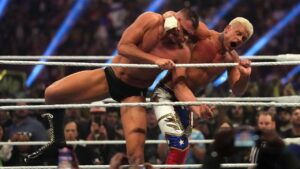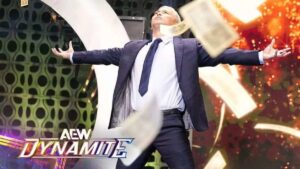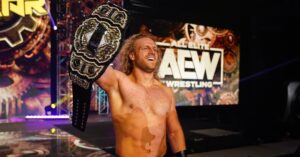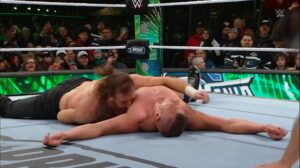The Pioneers is a new on-going series looking at some of the earliest pioneers of professional wrestling as we know it, from the wrestlers to promoters to trainers who helped shape professional wrestling around the world. Today we look at two brothers from London, England who became two of the first Black wrestlers to become stars in the early days of British professional wrestling, and in two eras. “Black Butcher” Arthur Johnson and “Johnny Kwango” John Lagey.
While professional wrestling for African-Americans was an option in the United States as far back as the carnival days of the late 1800s with such icons as Viro Small, a racially charged atmosphere less than 100 years from the end of the Civil War made it tougher to break into proper circuits and territories until the 1950s and 1960s. But in the United Kingdom, slavery had ended in 1834, following years of public outcry as far back as the 1770s. While systemic racism was still prevalent in British society, seeing Black Britons in everyday occupations was not seen in the same light as it was in the United States. Thanks to that, at least, the British professional wrestling scene saw the emergence of integrated Black wrestlers into its public eye much sooner than its US counterpart. As legend has it, a Black circus strongwoman named Irene Bess became Europe’s first Black professional wrestler during her carnival days in the late 1800s and early 1900s (although history has yet to prove this), but it was two of her sons who would make the history books as two of the best Black personalities in the early days of Great Britain’s pro wrestling industry.
“Black Butcher” Arthur Johnson
In 1912, Irene Bess (now Irene Howe) gave birth to her first son, Arthur Lowe (there are no birth records for an Arthur Lowe in England, leading many historians to believe he was born overseas, perhaps during one of his mother’s tours in Europe). By the time Arthur was 18 years old, professional wrestling in England was going through its most transformative state in decades. Throughout the 1800s and early 1900s, professional wrestling was very much akin to its United States cousins – competing at county fairs, mostly in the traditional Greco-Roman style of the time that had captivated Europe for decades. By by the end of War World I, the Greco-Roman style had waned, especially in Great Britain, and professional wrestling took a hit at the box office. In 1930, British wrestlers Atholl Oakeley and Henri Irslinger had a plan to revolutionize UK wrestling, much like the Goldust Trio (Ed ‘Strangler’ Lewis, Joseph ‘Toots’ Mondt & Billy Sandow) had in the US the previous decade. In the 1920s in New York, the trio had scrapped the ultra-realistic amateur wrestling styles of the day to focus more on predetermined finishes, controlling the entertainment and pacing of the matches. Goldust Trio also opened the doors wide open to all styles of wrestling to be performed – while previous promotions had limited to one specific style, like Greco-Roman, the trio created the Slam Bang Western Style Wrestling, which basically was “anything goes” as far as styles – Greco-Roman, Catch-As-Catch Can, free-style, and adding more theatric style big moves like body slams, suplexes, and boxing-like fisticuffs. In England, Irsligner – a former World Middleweight Champion in 1917 – and Oakeley, a technical grappler, created the British Wrestling Association, Britain’s first major collected pro wrestling company, and with it, introduced All-In Wrestling, a style that was equally as inclusive as the Goldust Trio’s Western Style. Oakeley would become the first British Heavyweight Champion.
Arthur Howe, weighing in around 180 lbs, was a skilled grappler in his own right, and was one of the earliest stars to sign with Oakeley’s new promotion in the early 1930s. He soon became Arthur Johnson and then simply “Black Butcher” Johnson, and was often nicknamed “The Wildman of Borneo”. Johnson worked against many of Oakeley’s top stars in the early days of the BWA, such as Ben Assirati, Carl Pojello, Jack Pye, and Bert Mansfield. But by the end of the 1930s, the city of London banned professional wrestling, and the industry went into almost darkness during the Second World War. It wasn’t until 1947 that pro wrestling made a comeback, and in 1952, UK’s top promoters in England and Scotland banded together to form Joint Promotions, a territorial banner head much like the National Wrestling Alliance (NWA) which had been created in the US only four years previous. In 1954, following the death of Henri Irslinger and the rise of Joint Promotions, BWA shut down. Black Butcher Johnson had been following the faster, more athletic paced wrestling that had began to infiltrate professional wrestling during World War II and quickly adapted it into his repertoire. In 1947, he started up Ashowe Publishing and produced Combat, one of Britain’s early boxing and wrestling magazines, so he was always discovering new stars who were coming into the business. Johnson was already considered one of the more charismatic performers in England and combining his previous technical prowess with more high spots and energy only made him a bigger star.
In 1954, he would win his first title, the World Middleweight Championship, in Aberdeen, Scotland, and the following year (again in Scotland, this time in Edinburgh), he bested Norman Walsh to win the World Light Heavyweight Championship. While his publishing company had gone under in 1952, by the late 1950s, he was also promoting his own group, under Ring Promotions, with smaller shows around London, but still remained a star with Joint Promotions as well. While British wrestling great “Gentleman” Chris Adams is widely considered the originator of the Superkick during his time in Texas in the early 1980s, the savate kick that Adams made a finisher and went on to be used by the likes of Shawn Michaels and The Young Bucks was actually Black Butcher Johnson’s finisher of choice during the bulk of his career. Sadly, Johnson retired from the sport in the 1960s, just as pro wrestling was about to find its greatest ally – television. But while Johnson would miss out on television’s influence on pro wrestling, his younger brother would pick up the family tradition and find himself a Black wrestling star for a new generation.
Johnny Kwango, “King of the Headbutt”
Only a few years after Johnson’s birth, his mother Irene remarried to a man named Auguste Lagey in 1916, and in 1920, she gave birth to her second son with Auguste, Johnny Lagey. Johnny had initially balked at his older half-brother’s career choice into pro wrestling and instead focused on the arts. He was a prominent musician, as an accomplished drummer and pianist, and often accompanied his other paternal brother, Cyril Lagey (born in 1918), in the London nightclubs. He was naturally athletic like his oldest brother, and in 1938, he made his own debut as a professional wrestler, initially wrestling as Bully Johnson (to connect with his brother’s name lineage in the sport). But when pro wrestling hit its slow period during the Second World War, he opted for a career change. A gifted dancer as well, he chose ballet, where he helped found Les Ballets Nègres in 1946, Europe’s first touring Black ballet company. Soon, he was touring the top European cities as a professional ballet dancer. But in 1949, he had returned to professional wrestling once again, as the business began to refind its footing, and he changed his name to his more famous moniker of Johnny Kwango.
By the early 1950s, Johnny had learned to inject some comedy into his performance, and soon he became a huge hit on the Joint Promotions circuit throughout England and Scotland, but it was in October of 1960 that he finally got a big break. He debuted on television. In his first match on this new medium, he faced one of the top heels in British wrestling at the time, “Iron Man” Steve Logan, and with his humor and athletic ability, he took the villainous Logan to the test. Johnny Kwango became an instant star for the new television audience and would become one of the most featured wrestlers for Joint Promotions’ legendary World of Sport Wrestling segments on ITV. He became known as the “King of the Headbutt”, which was his famous finisher. He would enter a legendary feud with another UK legend, Jackie Pallo, with the two even featured in a match at a tournament at the Royal Albert Hall presented to the Duke of Edinburgh himself, Prince Phillip.
Johnny Kwango would compete on World of Sport through the 1980s, finally retiring in 1984. Sadly, only three years later in 1987, his brother Black Butcher Johnson passed away at the age of 75. Johnny Kwango retreated from the business and passed away in January of 1994, aged 74. While neither of the sons of Irene Bess ever reached the heights of acclaim or legendary status that other UK legends did, they both paved the way for Black wrestlers to become stars, from the 1930s through the 1980s, and inspiring countless Black pro wrestlers in Great Britain to follow their dreams and become bigger stars in their own eras.
Check out more of our articles on The Pioneers of pro wrestling.
Stay tuned to the Last Word on Pro Wrestling for more on this and other stories from around the world of wrestling, as they develop. You can always count on LWOPW to be on top of the major news in the wrestling world, as well as to provide you with analysis, previews, videos, interviews, and editorials on the wrestling world.










